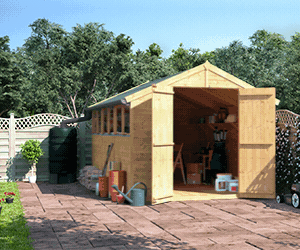Jump to:
The wood used in garden furniture is a natural material. This means it can wear out over time, more so when exposed to grim weather and elements. There’s no exception, regardless of how strong and durable the material is claimed to be. That’s why applying treatment is always a good idea; one option of weatherproofing.
This guide outlines the two best options to weatherproof your wooden garden furniture: wood oil and heavier sealants.
Treat with Wood Oil

(Image Credit: Wikimedia Commons)
Wood oils are made from plant extracts, mostly with nontoxic formulations. These oils revive worn wood surfaces and add a protective coating. They do so by penetrating deeply and replenishing the timber’s natural oils. Their sheen brings out the wood’s natural character, adding lustre rather than a gloss.
Take note, though, that wood oil can only be applied to unsealed wood furniture. Here are your best picks:
Danish oil
Danish oil is a mixture of an oil, a varnish, and a thinner. These ingredients make this popular oil water-resistant that dries to a hard finish. It provides more surface protection, e.g., UV filters, than plain oil finishes. Danish oil is easy to apply and work with, and you don’t have to worry about dust nibs when using it.
Teak oil
Teak oil contains linseed or tung oil, along with a mixture of mineral spirits, resins, and varnish. This composition can create a long-lasting, hard-wearing finish. It also offers good moisture protection and helps prevent mould. Teak oil is best used for hardwoods like teak furniture and those made of mahogany.
Tung oil
Tung oil is made from the pressed seeds of a tung tree nut, a tree native to China and a few other Asian countries. It dries quickly and is also non-toxic, like its Danish alternative. Plus, it offers a waterproof, flexible finish that allows timber to expand and contract with temperature and humidity changes. Tung oil doesn’t have UV protection qualities, but UV absorbers can be added to its formulation.
Apply Heavier Sealants

Sealants don’t “feed” the wood more oils, but instead, they seal in the oils that the wood contains. These sealants are made from plant oils, beeswax, or water-based resins. Their application can help prolong the life and wear of your timber furniture for a long time.
What’s more, heavier sealants prevent wood from becoming discoloured from absorbing water. The finish can vary from matte to glossy and comes in transparent varieties. Consider these options that have a thicker consistency, better resistance, and greater protection:
Spar varnish
Spar varnish is a wood-finishing varnish formulated to withstand water and weather. This exterior coating also contains ultraviolet additives for added sun protection. It’s marine-rated, so you can trust it will weatherproof your wood furniture capably. However, spar varnish takes considerable time to cure.
Spar urethane
Spar urethane is a type of polyurethane finish used to protect wood against weather. Its special additives allow the timber finish to expand and contract with changing seasons. These enhancers also make this sealant more resistant to UV light, water, and other environmental factors. It dries in a few hours, but apply several coats for the best effect.
Both options are available in oil-based and water-based products. Oil-based heavier sealants have great water resistance but take longer to dry. They also have a strong odour during application. Meanwhile, water-based variants use water as the solver and are drying faster. They have a clear finish and less odour, but their durability may not match that of oil-based options.
Round-up
Coating your wood garden furniture with oils and/or sealants can ensure each piece stands up to the weather. To get the best of both worlds, you can apply your choice of wood sealant after using wood oil. Just make sure the oil has fully cured before doing so. Always refer to the manufacturer’s recommendations for drying times and application procedures.
Pressure treatment is also favoured due to its resistance to rot, decay, and insect damage. To learn more about its advantages, read this guide next: The Advantages of Pressure Treated Sheds













What do you think ?